5 Calligraphy During the Three Kingdoms Period and Jin Dynasty
Part I. Culture
1 Historical Highlights
1.1 The Wei Period (220-265)
The Three Kingdoms Period (三国/三國/sān guó) included three distinctive states: the Wei (魏/wèi), the Shu (蜀/shŭ), and the Wu (吴/呉/wú). Among them, scholars of the art of calligraphy consider the Wei to have played the most prominent role. At the onset of the Wei, clerical style (隶书/隸書/lì shū) was still in use – a form followed by such noteworthy calligraphers as Zhong You (钟繇/锺繇), Wei Guan (卫琯/衞瓘), Huang Xiang (皇象), Handan Chun (邯郸淳/邯鄲淳), Suo Jing (索靖), and Liu Desheng (刘德升/劉德昇), among others.
The most celebrated was Zhong You (钟繇/锺繇/zhōng yóu) (151-230) who, it is said, created regular or standard script (楷书/楷書/kǎi shū). This came into use toward the end of the Han and matured in the Tang. Beginners tend to study regular script first because of easy-to-recognize characters that date from this era. Zhong’s calligraphy was compared to a “swan flying in the sky” and a “wild goose playing in the lake.” Emperor Liang Wu Di was so struck by Zhong’s genius that he said the calligraphy reflected “12 kinds of beauty.”
1.2 Jin Dynasty (Western Jin 265-316/317, Eastern Jin 317-420)
Two distinct periods characterize the Jin (晋/晉/jìn): the Western Jin (西晋/西晉/xī jìn), ruling China from 265 to 316/317AD, and the Eastern Jin (东晋/東晉/dōng jìn), from 317 to 420 AD. Although China was reunited under the Western in 280, it fell into civil war and was open to invasion shortly thereafter. This eventually led to the second division – the <Eastern.
2 Distinguished Calligraphers
2.1 Madame Wei (卫夫人/衞夫人)
Despite this turmoil, calligraphy attained its highest art form during the Jin, emblematic of renowned calligraphers such as Madame Wei (卫夫人/衞夫人/wèi fū ren) and Wang Xizhi (王羲之/wáng xī zhī ). Madame Wei is the presumed author of 笔阵图/筆陣圖/bĭ zhèn tú, an important book on calligraphy theory. In her writings she expressed a perspective on the standardized flow of calligraphy and emphasized the importance of brush, ink, ink stone and the seven brush-holding methods. Her role in the development of calligraphy is considered so significant that she is treated as the most renowned and revered female calligrapher in Chinese history.
2.2 Wang Xizhi (王羲之)
Wang Xizhi (303-361) was awarded the title of Calligrapher-Sage. His 兰亭集序/蘭亭集序/lán tíng jí xù (literally, Preface to the Poems Collected from the Orchid Pavilion), was regarded as the foremost authority on running style. Even though the original treatise was believed buried with an emperor, we can see traces of the work in copies written by great calligraphers who followed. For thousands of years Wang’s styles have become paradigms of Chinese calligraphy. Another one of his books, 书论/書論/shū lùn, On Calligraphy, is still regarded as a classic.

*
Part II. Calligraphy Writing
1 Brush Techniques
The two ends of a stroke can be made differently so as to have different appearances. Techniques often include 露锋/露鋒 and 藏锋/藏鋒.
1.1 露锋/露鋒
露锋/露鋒/lòu fēng refers to an exposed, or revealed, tip. To write a stroke with an exposed tip, one moves the brush in the original direction and purposely reveals the tip of the stroke. The stroke with the exposed tip looks sharp on the end.
1.2 藏锋/藏鋒
藏锋/藏鋒/cáng fēng is a concealed tip. To make a concealed tip requires starting with a short backward beginning (called 逆锋起笔/逆鋒起筆/nì fēng qĭ bĭ). To finish the stroke one makes an additional short backward movement (called 逆锋收笔/逆鋒收筆/nì fēng shōu bĭ). The stroke with the concealed tip look blunter.
2 Strokes: 钩/鈎
There are many types of hooks (钩/鈎/gōu) in Chinese calligraphy. Each is actually part of a stroke. These include: a hook with a vertical-hook; a bend-hook; a horizontal-turning-hook; and a horizontal-hook (Figure 2). Hooks can point to the left side (see Figure 2) or right side (see Chapter 6). All of them result from a sudden change of brush direction followed by a swift pointed end. The correct way of writing hooks, in general, is to pause at the turning point, change the writing direction, and then make the triangular-like hook end.
 |
 |
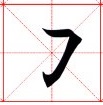 |
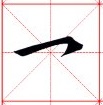 |
 |
 |
 |
 |
Figure 2: Four types of leftward hook
3 Composing Characters
3.1 Stroke Order
Arch Chinese lists 12 rules of Chinese character writing order. Below is Rule 6 (for review).
Rule 6: Center verticals before outside “wings” (e.g., 小, 水, and 山)
For details, visit the Arch Chinese website. Yellowbridge Online Dictionary can also provide additional information.
3.2 Characters
小/xiăo/small, little, young; 宇/yŭ/universe; 方/fāng/square, location
3.3 Sample Calligraphy Characters
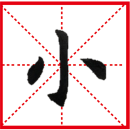 |
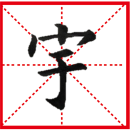 |
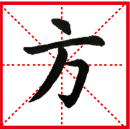 |
3.4 Writing by following rules.
- Prepare the tools and materials.
- Start to write under instruction.
- Be aware of rules for posture and stroke order.
4 Homework
4.1 Write the following characters:
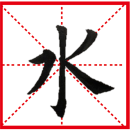 |
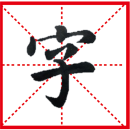 |
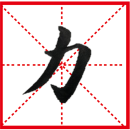 |
水/shuĭ/water; 字/zì/word, character; 力/lì/strength, power
4.2 Search on line for more calligraphers and their work during the Three Kingdom Period and Jin Dynasty.
*
Part III. Additional Resources
- Writing Techniques: http://www.asianbrushpainter.com/blog/knowledgebase/more-brush-techniques/#more-521
- The Palace Museum: http://en.dpm.org.cn/EXPLORE/artworks/1336.html
- Wei and Jin Dynasties: http://www.art-virtue.com/history/wei-jin/wei-jin.htm
- Chinasage: http://www.chinasage.info/dynastydisunity.htm

